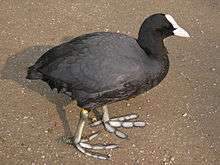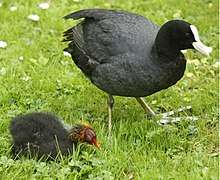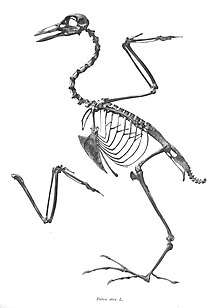Eurasian coot
| Eurasian coot | |
|---|---|
 | |
| Scientific classification | |
| Kingdom: | Animalia |
| Phylum: | Chordata |
| Class: | Aves |
| Order: | Gruiformes |
| Family: | Rallidae |
| Genus: | Fulica |
| Species: | F. atra |
| Binomial name | |
| Fulica atra Linnaeus, 1758 | |
 | |
| Range of F. atra Breeding range Year-round range Wintering range | |
| Synonyms | |
| |
The Eurasian coot (Fulica atra), also known as coot, is a member of the rail and crake bird family, the Rallidae. The scientific name is from Latin; Fulica is "coot", and atra is "black".[3] It is found in Europe, Asia, Australia and parts of Africa. The Australian subspecies is known as the Australian coot.
Distribution

The coot breeds across much of the Old World on freshwater lakes and ponds. It occurs and breeds in Europe, Asia, Australia, and Africa. The species has recently expanded its range into New Zealand. It is resident in the milder parts of its range, but migrates further south and west from much of Asia in winter as the waters freeze
Description
The Eurasian coot is 32–42 cm (13–17 in) long and weighs 585–1,100 g (1.290–2.425 lb),[4] and is largely black except for the white frontal shield (which gave rise to the phrase "as bald as a coot", in use as early as 1430).[5] As a swimming species, the coot has partial webbing on its long strong toes.
The juvenile is paler than the adult, has a whitish breast, and lacks the facial shield; the adult black plumage develops when about 3–4 months old, but the white shield is only fully developed at about one year old.
This is a noisy bird with a wide repertoire of crackling, explosive, or trumpeting calls, often given at night.
Behaviour

The Eurasian coot is much less secretive most of the rail family, and can be seen swimming on open water or walking across waterside grasslands. It is an aggressive species, and strongly territorial during the breeding season, and both parents are involved in territorial defence.[6] During the non-breeding season they may form large flocks, possibly related to predator avoidance.[7]
It is reluctant to fly and when taking off runs across the water surface with much splashing. It does the same, but without actually flying, when travelling a short distance at speed in territorial disputes. As with many rails, its weak flight does not inspire confidence, but on migration, usually at night, it can cover surprisingly large distances. It bobs its head as it swims, and makes short dives from a little jump.
 |
|
| Problems playing this file? See media help. | |
Breeding
This species builds a nest of dead reeds or grasses, but also pieces of paper or plastic near the water's edge or on underwater obstacles protruding from the water, laying up to 10 eggs, sometimes 2 or 3 times per season. Usually only a few young survive. They are frequent prey for birds such as herons and gulls.
Chick mortality occurs mainly due to starvation rather than predation. Most chicks died in the first 10 days after hatching, when they are most dependent on adults for food.[8] Coots can be very brutal to their own young under pressure such as the lack of food. They will bite young that are begging for food and repeatedly do this until it stops begging and starves to death. If the begging continues, they may bite so hard that the chick is killed.[9] Coots will also lay their eggs in the nests of other coots when their environment or physical condition limits their ability to breed, or to lengthen their reproductive life.[8]
Diet
The coot is an omnivore, and will take a variety of small live prey including the eggs of other water birds, as well as algae, vegetation, seeds and fruit.[10] It shows considerable variation in its feeding techniques, grazing on land or in the water. In the water it may upend in the fashion of a mallard or dive in search of food.[11]
Status
The Eurasian coot is one of the species to which the Agreement on the Conservation of African-Eurasian Migratory Waterbirds (AEWA) applies.
Fossil record
An extinct subspecies (Fulica atra pontica) has been described from the Eneolithic (around 4800-4400 BP) of Bulgarian Black Sea Coast.[12]
References
- ↑ BirdLife International (2012). "Fulica atra". IUCN Red List of Threatened Species. Version 2013.2. International Union for Conservation of Nature. Retrieved 26 November 2013.
- ↑ Condon, H.T. (1975). Checklist of the Birds of Australia: Non-Passerines. Melbourne: Royal Australasian Ornithologists Union. p. 57.
- ↑ Jobling, James A (2010). The Helm Dictionary of Scientific Bird Names. London: Christopher Helm. pp. 58, 165. ISBN 978-1-4081-2501-4.
- ↑ Dunning, John B. Jr., ed. (1992). CRC Handbook of Avian Body Masses. CRC Press. ISBN 978-0-8493-4258-5.
- ↑ "Coot". Oxford English Dictionary (3rd ed.). Oxford University Press. September 2005. (Subscription or UK public library membership required.)
- ↑ Cavé, A.J.; Visser, J.; Perdeck, A.C. (1989). "Size and quality of the Coot (Fulica atra) territory in relation to age of its tenants and neighbours" (PDF). Ardea. 77: 87–97.
- ↑ van den Hout, P.J. (2006). "Dense foraging flotillas of Eurasian coots Fulica atra explained by predation by Ganges soft-shell turtle Aspideretus gangeticus?" (PDF). Ardea. 94 (2): 271–274.
- 1 2 "This Coot has a Secret! - NatureOutside". 20 June 2015.
- ↑ Attenborough, David (16 December 1998). "The Problems of Parenthood". The Life of Birds. Episode 9. 12 minutes in. BBC One.
- ↑ Martin R., Perrow; Schutten, J. Hans; Howes, John R.; Holzer, Tim; Madgwick, F. Jane; Jowitt, Adrian J.D. (1997). "Interactions between coot (Fulica atra) and submerged macrophytes: the role of birds in the restoration process". Hydrobiologia. 342/343: 241–255. doi:10.1023/A:1017007911190.
- ↑ Bakker, Brigitte J.; Fordham, Robin A. (1993). "Diving behaviour of the Australian coot in a New Zealand lake" (PDF). Notornis. 40 (2): 131–136.
- ↑ Boev, Z.; Karaivanova, E. (1998). "Fulica atra pontica subsp. n. from the Middle Holocene on the South Black Sea Coast, Bulgaria". Historia naturalis bulgarica. 9: 53–69.
External links
| Wikimedia Commons has media related to Fulica atra. |
| Wikispecies has information related to: Fulica atra |
- "Common Coot media". Internet Bird Collection.
- Eurasian coot photo gallery at VIREO (Drexel University)
- Ageing and sexing (PDF; 1.8 MB) by Javier Blasco-Zumeta & Gerd-Michael Heinze
- Feathers of Eurasian Coot (Fulica atra)
- BirdLife species factsheet for Fulica atra
- "Fulica atra". Avibase.

- Audio recordings of Eurasian coot on Xeno-canto.
